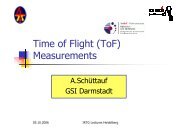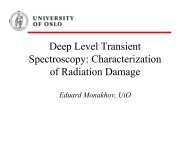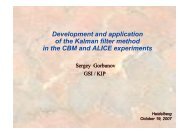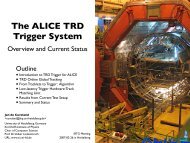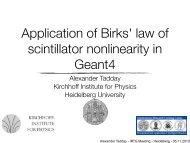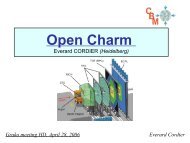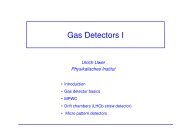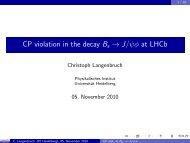Particle Identification @ ALICE - IRTG Heidelberg
Particle Identification @ ALICE - IRTG Heidelberg
Particle Identification @ ALICE - IRTG Heidelberg
You also want an ePaper? Increase the reach of your titles
YUMPU automatically turns print PDFs into web optimized ePapers that Google loves.
Partcile Production from<br />
<strong>Particle</strong> <strong>Identification</strong> @ <strong>ALICE</strong>,<br />
SIS to the LHC<br />
Techniques and physics interpretation<br />
Helmut Oeschler<br />
Darmstadt University of Technology<br />
and<br />
CERN<br />
May 11 th , 20010
Melting Matter<br />
smooth crossover
Size: 16 x 26 meters<br />
Weight: 10,000 tons
<strong>Particle</strong> identification using three detectors:<br />
Some steps in building the time projection chamber TPC<br />
Calibration, cosmic rays, pp collisions<br />
Time of Flight<br />
Inner Tracker System<br />
Results from the various detectors,<br />
Final spectra and their understanding<br />
Measuring particle yields and<br />
what we can learn from it
October 2006
The <strong>ALICE</strong> Time Projection Chamber (TPC)<br />
• main tracking and particle identification detector of Alice<br />
• delivers almost complete picture of the collision:<br />
tracking, particle momentum (pT = 0.3 B r), and particle ID<br />
⋅ ⋅ 7<br />
07.10.2009 | A.Kalweit@GSI.de<br />
5 m
The time projection chamber (TPC)<br />
largest ever<br />
88 m3, l = 5 m, d = 5.6m<br />
570 k channels<br />
lightweight,<br />
powerful FEE<br />
Radius 2.5 m<br />
Length: 5 m<br />
Volume: 95 m 2<br />
Gas: Ne CO 2 N 2
TPC
energy-loss formula<br />
• energy loss per unit path length is described by the Bethe-<br />
Bloch formula<br />
(depends only on charge and rest mass for a fixed<br />
momentum)<br />
• parameterization is fitted to the data (Aleph-<br />
Parameterization):<br />
07.10.2009 | A.Kalweit@GSI.de
<strong>Particle</strong> identification via specific energy loss<br />
• energy loss per unit path length is described by Bethe-Bloch formula:<br />
• depends only on charge<br />
and rest mass for a fixed<br />
momentum<br />
-> particle ID<br />
• scaling variable:<br />
βγ<br />
= p/m<br />
07.10.2009 | A.Kalweit@GSI.de<br />
11<br />
MC
TPC Krypton calibration<br />
• Prerequisite for precise PID: Gain of 557568 pads has to be equalized<br />
• Injection of radioactive Krypton: Rb -> Kr* -> Kr<br />
A. Matyja, Cracow<br />
07.10.2009 | A.Kalweit@GSI.de<br />
41.6 keV<br />
C side Gain Map
Field defining potential network
Calibration with laser beams
Calibration with cosmics<br />
• <strong>ALICE</strong> TPC started cosmic data taking in February 2008, long run during 2009<br />
• Almost all necessary calibrations were carried out with this data.<br />
cosmic event<br />
07.10.2009 | A.Kalweit@GSI.de<br />
15<br />
dE/dx spectrum<br />
from 7 million<br />
cosmic ray events
With magnetic field
First TPC pp event<br />
6 Dec 2009
900 GeV pp data
Parametrize the dE/dx<br />
for the various particles<br />
Slices in pt<br />
Difference between<br />
measured value and<br />
parametrized one<br />
For charged particles:<br />
pi, K and p
Secondary vertex studies:<br />
+PId<br />
Basis of topological identification<br />
Weak decay of strange particles<br />
displaced vertices (cτ ~cm)<br />
charged decay daughters<br />
K 0 s , Λ, Ξ- and Ω -<br />
high branching ratio (>64%)<br />
Reconstruction from charged tracks<br />
tracking inward<br />
secondary track selection<br />
displaced vertex finder<br />
<strong>Identification</strong> of secondary vertices<br />
quality selection (ITS clusters…)<br />
daughter PId (dE/dx, TOF, etc…)
Changes in the Reconstruction and the<br />
ESD
Λ → πp<br />
<strong>ALICE</strong> in full glory
Results from 900 GeV pp data<br />
Λ → πp<br />
PDG: 1115.7 MeV<br />
Λ → πp<br />
PDG: 1115.7 MeV<br />
K 0 s<br />
→ ππ<br />
PDG: 497.6 MeV<br />
φ → Κ + Κ −<br />
PDG: 1019.5 MeV
Lambda analysis with and without PID<br />
With PID:<br />
PID cut at 3 sigma<br />
Without PID:
Secondary vertex studies:<br />
simulation<br />
Multi-strange particle analysis ?<br />
3 prong decays for Ξ and Ω<br />
association of 3 tracks<br />
High multiplicity environment<br />
dNch /dy ~2000 (?)<br />
2 units of rapidity<br />
2 tracks: 2000 pos x 2000 neg<br />
3 tracks: …<br />
compromise efficiency / purity<br />
Candidate quality evaluation<br />
kinematical variables<br />
distances of closest approach<br />
χ 2 calculations
Ξ reconstruction
Kaon/pion ‘identification’ from their<br />
weak decay inside <strong>ALICE</strong> TPC detector<br />
24/05/10 28<br />
<strong>ALICE</strong> Week, PWG2, MSS<br />
K<br />
K<br />
K<br />
K<br />
K<br />
→<br />
μν<br />
→ ππ<br />
→ eπ<br />
→<br />
μπ<br />
→ ππ<br />
K- kinks<br />
0<br />
ν<br />
0<br />
0<br />
0<br />
ν<br />
π<br />
0<br />
π- - kinks<br />
π →<br />
μ ν<br />
63.<br />
43%<br />
21.<br />
13%<br />
4.<br />
87%<br />
3.<br />
27%<br />
1.<br />
73%<br />
99%
<strong>ALICE</strong> Data pp interactions at 900 GeV, KinkAngle VRS Mother Mom.<br />
All Kinks<br />
Blue:π Limit, Red:K Limit<br />
24/05/10 29<br />
<strong>ALICE</strong> Week, PWG2, MSS<br />
Selected Kaon-kinks
<strong>ALICE</strong> MC (left) and Data(right) pp interactions at 900 GeV, K-kinks<br />
MC<br />
24/05/10 30<br />
<strong>ALICE</strong> Week, PWG2, MSS<br />
<strong>ALICE</strong> Data
<strong>ALICE</strong> Data pp interactions at 900 GeV, K-kinks Pt, Raw and corrrect<br />
MC<br />
24/05/10 31<br />
<strong>ALICE</strong> Week, PWG2, MSS<br />
Data, 3σ cut
<strong>ALICE</strong> MC pp interactions at 900 GeV, K-kinks correction factors<br />
24/05/10 32<br />
<strong>ALICE</strong> Week, PWG2, MSS<br />
Blue->K+, Red->K-<br />
Fraction of decaying<br />
kaons in the given<br />
volume<br />
Probability of finding the<br />
kink decays
<strong>ALICE</strong> Data pp interactions at 900 GeV, K-kinks Pt, Raw and corrrect<br />
24/05/10 33<br />
<strong>ALICE</strong> Week, PWG2, MSS
Time-of-flight Detector
Time difference between measured t TOF and<br />
calculated (based on pass length)
TPC<br />
SPD cone<br />
SSD/SDD<br />
IT<br />
S<br />
SPD barrel<br />
SPD<br />
Inner Tracking System<br />
~ 10 m 2 Si detectors, 6 layers<br />
Pixels, Drift, double sided Strips
Inner Tracking System (II)<br />
• Design goals<br />
– Optimal resolution for primary vertex and track<br />
impact parameter<br />
• Minimize distance of innermost layer from beam axis<br />
(≈ 3.9 cm) and material budget<br />
– Maximum occupancy (central PbPb) < few %<br />
– 2D devices in all the layers<br />
– dE/dx information in the 4 outermost layers for<br />
particle ID in 1/β 2 region<br />
Layer Det.<br />
Type<br />
Radius<br />
(cm)<br />
Length<br />
(cm)<br />
Resolution<br />
(μ m)<br />
PbPb dN/dy=6000<br />
rφ Z Part./cm 2 Occupancy<br />
(%)<br />
1 SPD 3.9 28.2 12 100 35 2.1<br />
2 SPD 7.6 28.2 12 100 12 0.6<br />
37
ITS role in <strong>ALICE</strong> physics (II)<br />
• Vertexing<br />
– Reconstruction of primary (interaction) vertex<br />
Resolution [μ m]<br />
• From tracks: ITS crucial to obtain resolution better than 100 μm<br />
• From SPD tracklets: done before tracking and used as a starting point (seed) in the<br />
tracking phase. Allows for pileup tagging based on multiple vertices<br />
– <strong>Identification</strong> of secondary vertices from decays of hyperons and open charm and<br />
beauty hadrons<br />
Primary vertex resolution vs.<br />
multiplicity in p-p<br />
Vertex from tracks<br />
Interaction diamond:<br />
σ x,y =50 μm<br />
D + → K - π + π + decay vertex<br />
resolution<br />
38
SDD<br />
Central<br />
Cathode<br />
at -HV<br />
70.2 mm<br />
Voltage divider<br />
E drift<br />
E drift<br />
v d (e - )<br />
v d (e - )<br />
Modules mounted<br />
on ladders<br />
Anodes<br />
HV supply<br />
Front-end electronics (4 pairs of ASICs)<br />
-> Amplifier, shaper, 10-bit ADC, 40 MHz<br />
sampling<br />
LV supply<br />
Commands<br />
Trigger<br />
Data <br />
Cooling (H 2 O) tubes<br />
Cables to power<br />
supplies and DAQ<br />
Carbon fiber support<br />
Layer # ladders Mod./ladde<br />
r<br />
SDD layers<br />
into SSD<br />
# modules<br />
3 14 6 84<br />
4 22 8 176<br />
39
Pid via Energy loss
Same procedure as for TPC
Kaon analysis via the different methods
What do we learn from<br />
the spectra?
Thermallyshaped<br />
Soft<br />
Production<br />
Hard<br />
Scattering<br />
hep-ex/0305013 S.S. Adler et al.<br />
RHIC<br />
PHENIX<br />
p+p->π 0 + X
a first glimpse of mini-<br />
jets<br />
ITS-TPC matching and tracking
a first glimpse of mini-<br />
<strong>ALICE</strong> TPC Di-jet<br />
jets<br />
angular distribution of<br />
particles in TPC relative to<br />
a high p t trigger particle<br />
(single event!)
Spectra from RHIC p+p and Au+Au<br />
exponential low-energy<br />
part with a pronounced<br />
tails towards high<br />
momenta<br />
How to compare p+p with<br />
Au+Au?<br />
Volume?<br />
Bulk, N part<br />
Number of NN collisions?<br />
Hard collisions, N coll
Deuterons and anti-deuterons selection<br />
Natasha Sharma, PWG2 Meeting,<br />
March 23rd, 2010<br />
Thanks to Alexander<br />
Kalweit<br />
48
Anti deuteron<br />
Natasha Sharma, PWG2 Meeting,<br />
March 23rd, 2010<br />
49
Outlook for 7 TeV
Statistical Model<br />
Strangeness Suppression in pp<br />
Resonance Suppression in HI<br />
− In pp particle ratios are well described using canonical description<br />
− In Au+Au only stable particle ratios are well described<br />
Observed strangeness enhancement NOT signal for a QGP!
• Chemical decoupling<br />
conditions extracted<br />
from SIS up to RHIC<br />
feature common<br />
behavior<br />
• parametrisation e.g.<br />
T - μ B – systematics<br />
Nucl. Phys. A 697 (2002)<br />
902<br />
J. Cleymans, HO, K. Redlich, S. Wheaton,<br />
Phys. Rev. C 73 (2006) 034905
Chemical Freeze Out<br />
Data points:<br />
T μ B<br />
Hadronization<br />
Towards LHC!<br />
T ≈ 170 MeV<br />
μ B ≈ 1 MeV
Freeze-out parameters using the anti p/p ratio<br />
pp 900 GeV<br />
<strong>ALICE</strong><br />
pp 200 GeV<br />
STAR<br />
I. Kraus, et al., PRC 79 (2009) 014901
Predictions for pp and HI at LHC<br />
Prediction for<br />
heavy ions:<br />
Grand can.<br />
I. Kraus et al.,<br />
PRC 74 (2007)<br />
034903
~ 1000 Members<br />
~ 30 Countries<br />
~ 100 Institutes
Thank you!



